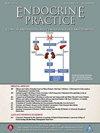Emerging and Established Adverse Events of Pasireotide: A Twelve-Year Pharmacovigilance Study
IF 4.6
3区 医学
Q2 ENDOCRINOLOGY & METABOLISM
引用次数: 0
Abstract
Objectives
This study aimed to provide a comprehensive assessment of pasireotide's real-world safety profile by analyzing adverse events (AEs) reported in the FDA Adverse Event Reporting System (FAERS).
Methods
FAERS data from Q4 2012 to Q3 2024 were retrospectively analyzed using disproportionality methods, including the reporting odds ratio, proportional reporting ratio, Bayesian confidence propagation neural network, and multi-item gamma Poisson shrinker. Descriptive analyses evaluated clinical characteristics such as age, sex, country of report, and time to AE onset, while subgroup analyses assessed variations in AE occurrence across demographic groups.
Results
A total of 7892 pasireotide-related AEs were identified across 27 system organ classes. Frequently reported AEs included hyperglycemia, cholelithiasis, and gastrointestinal disturbances, with hyperglycemia being the most common. Emerging safety signals were identified, including nephrolithiasis, sudden hearing loss, ptosis, and atrioventricular block. Subgroup analyses indicated that metabolic AEs were more prevalent in females, while males reported higher rates of gastrointestinal symptoms. Older patients were more susceptible to cardiovascular AEs.
Conclusions
This study underscores the need for ongoing pharmacovigilance to detect both established and emerging AEs associated with pasireotide. Implementing personalized monitoring strategies based on demographic factors such as age and sex can help mitigate risks and optimize treatment outcomes, enhancing patient safety in clinical practice.
帕西肽新出现和已确定的不良事件:一项为期12年的药物警戒研究。
目的:本研究旨在通过分析FDA不良事件报告系统(FAERS)中报告的不良事件(ae),对pasireotide的实际安全性进行全面评估。方法:采用歧化方法对2012年第4季度至2024年第3季度的FAERS数据进行回顾性分析,包括报告优势比、比例报告比、贝叶斯置信传播神经网络和多项目伽玛泊松收缩器。描述性分析评估临床特征,如年龄、性别、报告国家和发生AE的时间,而亚组分析评估不同人口统计学组间AE发生的变化。结果:在27个系统器官分类中共鉴定出7892个与paspasinotide相关的ae。常见的不良反应包括高血糖、胆石症和胃肠道紊乱,其中高血糖最为常见。新出现的安全信号被确定,包括肾结石、突发性听力损失、上睑下垂和房室传导阻滞。亚组分析表明,代谢性不良反应在女性中更为普遍,而男性报告的胃肠道症状发生率更高。老年患者更容易发生心血管ae。结论:这项研究强调了持续进行药物警戒的必要性,以检测与pasireotide相关的已建立和新出现的ae。实施基于年龄和性别等人口统计因素的个性化监测策略有助于降低风险,优化治疗结果,提高临床实践中的患者安全性。
本文章由计算机程序翻译,如有差异,请以英文原文为准。
求助全文
约1分钟内获得全文
求助全文
来源期刊

Endocrine Practice
ENDOCRINOLOGY & METABOLISM-
CiteScore
7.60
自引率
2.40%
发文量
546
审稿时长
41 days
期刊介绍:
Endocrine Practice (ISSN: 1530-891X), a peer-reviewed journal published twelve times a year, is the official journal of the American Association of Clinical Endocrinologists (AACE). The primary mission of Endocrine Practice is to enhance the health care of patients with endocrine diseases through continuing education of practicing endocrinologists.
 求助内容:
求助内容: 应助结果提醒方式:
应助结果提醒方式:


